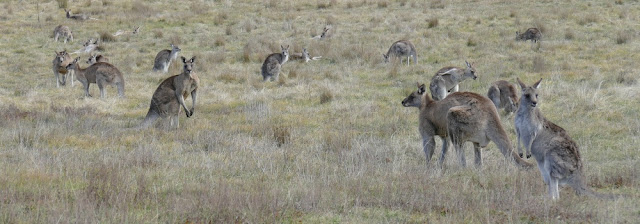We have now got to the final instalment of this celebration of a great park, Namadgi, which is Canberra's back yard. Sadly it has been grievously burnt in the past few weeks, but the fire is effectively out now and recovery has begun. I had hoped to get permission to accompany parks staff into the area to report to you, as I did in 2003, but it seems this is not going to happen. Meantime the park, including the unburnt areas, is going to remain closed for an indefinite period. If you've just found this series, you might like to go back to the start for background that may be of interest.
Today we're going to enjoy some of the bigger animals - the vertebrates (mammals, birds and reptiles - I don't have any Namadgi frogs or fish to offer you, unfortunately).
 |
| A small part of the mob we passed through on an autumn walk a couple of years ago. |
They're not the only macropods in the park of course, though the others don't normally gather socially. (For a lot more on macropods - kangaroos, wallabies and their kin - see here.)
Reptiles are easy to see on any summer walk (assuming it's warm of course, never to be presumed in the Alps). Skinks are the most likely reptiles to be seen; most are small and quick, but one giant skink is a special attraction.
 |
| Blotched Bluetongue Tiliqua nigrolutea by the Mount Franklin Road. This lovely lizard is truly a giant among skinks, growing to 45cm long and weighing in excess of a kilo. In Tasmania it is found at sea level, but as we go north on the mainland it is found at higher altitudes. (More on bluetongues here.) |
 |
| Highland Water Skinks Eulamprus tympanum are found high in the northern Brindabellas, including here at Bulls Head. They are common on logs or rocks, and often near water - this one wasn't though. |
 |
| Grass Skink Lamprophilus guitchenoti, Rendezvous Creek walk. This common little skink (only 90mm long) is found at all altitudes in the ACT. |
Snakes are not uncommon, but mostly shy and rarely encountered. In summer though Highland Copperheads are likely to be out on the roads on sunny days.
Which brings us to birds, which are of course a conspicuous part of any landscape. I shouldn't be surprised to realise how many of the following bird pics were taken in the lovely little woodland patch immediately behind the Namadgi Visitor Information Centre - it's after all one of my favourite birding sites in the ACT. Unfortunately it too is closed to the public at present; I understand why most of the park needs to be inaccessible at the moment, but this one I find a little puzzling. It's on the northern fringe of the park not far from the suburbs, with easy access, and thus escape in emergency. It wouldn't seem to be hazardous on days that weren't high fire risk, and wouldn't put strain on parks staff. However, they have enough to think about at present.
The next eight pictures were all taken there on various visits, mostly in the early mornings.
 |
| Rainbow Bee-eater Merops ornatus with dragonfly, a staple of their diet, being large and nutritious. Another migrant which arrives here to breed over summer, though it excavates burrows in banks. |
 |
| ... as was this Spotted Pardalote Pardalotus punctatus, an abundant tiny bird which lives by gleaning tiny animals from the foliage. It is common from the Snow Gums to the suburbs. |
Another good woodland birding area in Namadgi is further south along the Boboyan Road, around the Glendale works depot and along the Old Boboyan Road in the nearby Gudgenby Valley (where the roos above were). The fires went right through there, but I have no idea how intensely, or how patchy or otherwise it was. In general I'd expect woodland to recover reasonably well (as it did after 2003).
Given the overall state of woodlands, it's to be expected that several species reliant on woodland are listed as Threatened; the first two species below are in that category.
 |
| Male Scarlet Robin Petroica boodang; there are not many sites in the ACT these days where we can fairly reliably see these brilliant little insect-eaters. |
\ |
| Diamond Firetail Stagonopleura guttata; a delightful little grass-finch, to which this photo certainly doesn't do justice. |
 |
| Common Bronzewing Phaps chalcoptera, a common pigeon from Canberra to the high Brindabellas. This one was sunning on a rock outcrop in the Gudgenby Valley. |
 |
| Immature Fuscous Honeyeater Ptilotula fusca; not common in the ACT in general, but this area is a hotspot for it. Adults have a black bill and a black and yellow cheek stripe. |
The last three Namadgi birds featured here are found high up in the Snow Gums in summer, though at least two move downslope with the snows.
So that's it for our tribute to wonderful Namadgi. Hopefully those responsible will relent and let us back to this grand peaceful landscape earlier than planned; many of us need that. Meantime I hope this series can help tide us over until that date comes.
NEXT POSTING THURSDAY 12 MARCH.
And remember that you can get a reminder when the next post appears by putting your email address in the Follow by Email box in the top right of this screen.
I'd love to receive your comments - it's easy and you don't need to sign in!
And remember that you can get a reminder when the next post appears by putting your email address in the Follow by Email box in the top right of this screen.
I'd love to receive your comments - it's easy and you don't need to sign in!













































